
The core focus of office design is a balance between aesthetic considerations and functionality, which can result in significant environmental and economic benefits when paired with well-managed project delivery.
By implementing cost-neutral building maintenance and refurbishment techniques and principles, businesses can reduce energy consumption and recurring embodied carbon while also lowering workplace operating costs and improving staff wellbeing.
An increasingly common example is energy-efficiency certification for buildings, with high demand from owners and occupiers for sustainable fit-outs and a growing appetite for third-party certifications that verify the building meets certain environmental standards, including wellbeing and building connectivity standards.
Recent innovations have enabled office fit-out solutions to incorporate new types of ergonomic furniture, integrate smart and touchless technologies, apply biophilic design principles, and formulate new ways of designing collaborative spaces.
Rapidly expanding in adoption after the COVID-19 pandemic, touchless technology offers ideal safety and environmental standards with motion sensors for wash areas, lights activated by motion detectors, contactless temperature checking devices, elevators and audio-visual systems that can be controlled using digital devices, and improved air filtration.
Other technologies transforming modern office spaces include integrated conference and meeting solutions, high-speed internet connectivity, cloud and server database management, tech- friendly infrastructure for cabling and wiring, and shared digital spaces.
The integration of technology has made it easier for optimal design to be stylish, such as sleek and ergonomic furniture and wire management systems and tech-enabled furniture including wall mounts and recessed power strips.
Smart systems have also supported biophilic design principles by offering greater control over critical wellbeing factors such as lighting and air quality.
Biophilic design, or the adaption of natural elements into inside spaces, helps reduce employee stress levels, leading to improved productivity, a stronger company culture, and better staff attraction and retention.
Examples of biophilic office design include using natural materials for finishes such as wood and stone; water features like fountains, pools or indoor waterfalls; adding real plants; maximising earth-tone colours; and utilising textures and pictures that elicit the feeling of nature.
These design elements can be used to positively portray a brand image or uplift internal work culture, as well as creating a good first impression when clients or visitors first enter the space.
More often than not, biophilic design closely aligns with sustainability and circular economy principles, which is becoming a fundamental component of how office fit-outs are designed and delivered.
Research conducted at the University College London aimed to more fully quantify and profile the rate of retrofits in multi-storey office buildings in Australia, as a necessary first step in measuring the impact of the refurbishment process on recurring embodied energy.
A socio-technical analysis was developed for office fit-outs and used to recognise key incentives and mechanisms that encourage higher rates of reuse, remanufacture, and closed-loop recycling.
The research found the fit-out supply chain generally showed a linear tendency for both decisions and material flows, while a ‘reuse third party’ in the supply chain helped facilitate the salvage of building components that would otherwise be treated as waste.
It was also recognised that communication mainly took place between stakeholders that were adjacent in the supply chain, with generally no effective communication among non-adjacent supply chain actors.
Rates of replacement for building products are typically shorter than their lifespans, and the main barriers to potential reuse were found to be both the lack of size standardisation and the lack of modular installation.
Material flow analyses showed that most waste streams were downcycled into products or uses that required inferior material quality and little waste was closed-loop recycled – mixed waste was the highest-mass waste stream generated, followed by plasterboard and wood.
The research proposed several policy and practical recommendations to support the transition of the fit-out industry towards a circular economy, organised into different groupings such as regulation and assessment (the identification of shortcomings in the waste management regulatory framework and the outline of fit-out benchmarking indicators).
Other broad dimensions included information (methodology for pre-refurbishment audits), organisation (circular logistic alternatives through the use of third parties in the supply chain), and technical and design issues (mechanisms for better onsite waste segregation and design improvements for more circular building fit-outs and products).
Notably, the research suggested there was a need to view embodied energy under two distinct categories of ‘initial’ and ‘recurring’.
The author explained: “In broad terms, initial embodied energy is the energy that goes into the physical construction of new
buildings; recurring embodied energy relates to the energy that goes into the ongoing refurbishment, retrofit and maintenance of existing buildings, and can therefore manifest continuously over a significant period of the building lifecycle.
“To some degree, there is often a perceived benefit in retrofit where more efficient fittings are installed to reduce operational greenhouse gas emissions, however the measures do add to total embodied carbon.”
Another study has shown that even though internal finishes only constituted 12 to 15 per cent of initial embodied energy, they were the most regularly replaced items over the life of a building and often involved high recurring embodied energy components.
Moreover, services are closely linked to internal refurbishment work and could add substantially to the recurring embodied energy over a building’s lifecycle, while the grade of fit-out can significantly influence a building’s embodied energy, depending on the frequency of replacement.
The author added: “The frequency and scope of office fit-outs is akin to a short-term consumable – rather than a long-term durable – in many multi-storey buildings.
“There may be a subsequent need to re-think the design of office fit-outs to suit a much shorter life – one that allows easy fabrication and equally easy de-fabrication and re-use.
“This would facilitate less recurring embodied energy over the life of the building and could be designed in conjunction with existing green building principles.”




